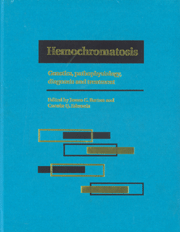Book contents
- Frontmatter
- Contents
- List of contributors
- Foreword
- Part I Introduction to hemochromatosis
- Part II Genetics of hemochromatosis
- 3 Inheritance of hemochromatosis: family studies
- 4 Hemochromatosis: population genetics
- 5 Variation of hemochromatosis prevalence and genotype in national groups
- 6 Human leukocyte antigen (HLA) association and typing in hemochromatosis
- 7 Localization, allelic heterogeneity, and origins of the hemochromatosis gene
- 8 The ancestral haplotype in hemochromatosis
- 9 Evidence for multiple hemochromatosis genes
- Part III Metal absorption and metabolism in hemochromatosis
- Part IV Diagnostic techniques for iron overload
- Part V Complications of iron overload
- Part VI Therapy of hemochromatosis and iron overload
- Part VII Infections and immunity in hemochromatosis
- Part VIII Hemochromatosis heterozygotes
- Part IX Relationship of hemochromatosis to other disorders
- Part X Animal models of hemochromatosis and iron overload
- Part XI Screening for hemochromatosis
- Part XII Hemochromatosis: societal and ethical issues
- Part XIII Final issues
- Index
8 - The ancestral haplotype in hemochromatosis
from Part II - Genetics of hemochromatosis
Published online by Cambridge University Press: 05 August 2011
- Frontmatter
- Contents
- List of contributors
- Foreword
- Part I Introduction to hemochromatosis
- Part II Genetics of hemochromatosis
- 3 Inheritance of hemochromatosis: family studies
- 4 Hemochromatosis: population genetics
- 5 Variation of hemochromatosis prevalence and genotype in national groups
- 6 Human leukocyte antigen (HLA) association and typing in hemochromatosis
- 7 Localization, allelic heterogeneity, and origins of the hemochromatosis gene
- 8 The ancestral haplotype in hemochromatosis
- 9 Evidence for multiple hemochromatosis genes
- Part III Metal absorption and metabolism in hemochromatosis
- Part IV Diagnostic techniques for iron overload
- Part V Complications of iron overload
- Part VI Therapy of hemochromatosis and iron overload
- Part VII Infections and immunity in hemochromatosis
- Part VIII Hemochromatosis heterozygotes
- Part IX Relationship of hemochromatosis to other disorders
- Part X Animal models of hemochromatosis and iron overload
- Part XI Screening for hemochromatosis
- Part XII Hemochromatosis: societal and ethical issues
- Part XIII Final issues
- Index
Summary
Introduction
Many chromosomal loci occur in different forms in different individuals; these different forms are called alleles. A haplotype can be defined as the alleles at different loci that are inherited from one parent. The presence of an ancestral haplotype in hemochromatosis, concomitant with a common ancestral origin for the disorder, was first proposed by Simon et al. in 1987. The aim of this chapter is to present the evidence that such a haplotype exists, and to describe its geographical distribution and likely origin. Because the HFE gene has now been identified, the characterization of the ancestral haplotype postgene identification will be discussed, together with the implications this has on our understanding of the apparent correlation between the presence of the ancestral haplotype and severe clinical expression of hemochromatosis.
Haplotype analysis in hemochromatosis
A significant step towards understanding the pathogenesis of hemochromatosis came in 1975 with the demonstration that the gene for hemochromatosis was clearly linked to HLA-A3 in the Brittany population in France. Subsequent studies confirmed the HLA-A3 association in other countries: for example, the UK3, Canada, Australia, Germany Sweden, and the US. The HLA-A gene is a classical class I MHC gene, which lies close to the other classical class I genes of the MHC on the short arm of chromosome 6 at 6p21.3. These genes are highly polymorphic and are thus represented by many allelic forms. Alleles at HLA-A and HLA-B are usually inherited together in an HLA haplotype, their joint inheritance being a function of their close physical proximity.
- Type
- Chapter
- Information
- HemochromatosisGenetics, Pathophysiology, Diagnosis and Treatment, pp. 91 - 98Publisher: Cambridge University PressPrint publication year: 2000
- 7
- Cited by



